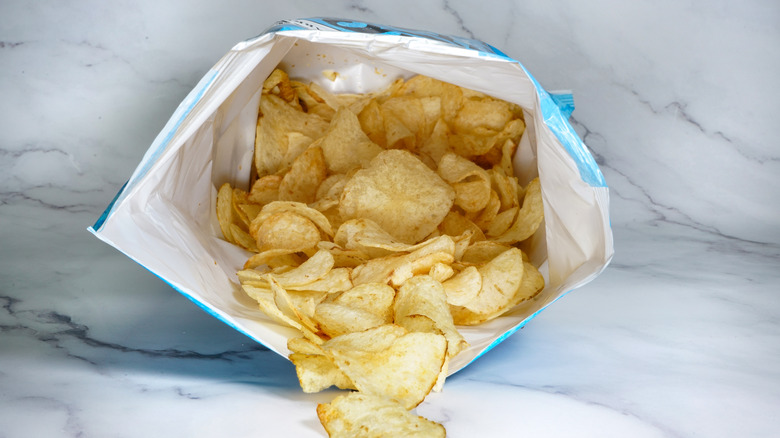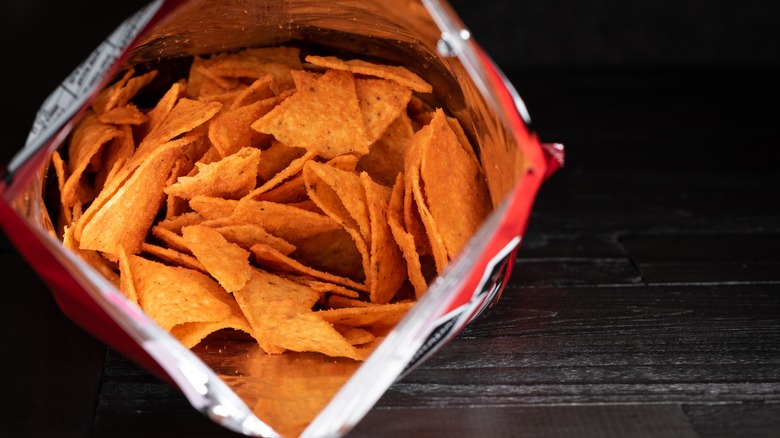There's Actually A Reason For The Extra Air In Potato Chip Bags
If it seems like there's more air in potato chip bags than ever before, that may be true. Shrinkflation, or the act of reducing quantity in order to keep prices the same, is a very real phenomenon. In 2022, for example, Food & Wine reported that there are now around five less Doritos chips in every bag. Other brands have followed a similar strategy. But, even during those long-ago halcyon days of fuller chip bags, there was still a good deal of air inside. Why? Because a certain amount is necessary to protect the chips from breakage and to ensure freshness. Although, technically, it's not just air, but also gas. Nitrogen gas, to be exact.
The technical term for this type of packaging is "slack fill," and, according to the U.S. Food and Drug Administration (FDA), it's legally permissible if the air padding is functional. Otherwise, the packaging can rightly be termed "misleading," and thus illegal. Has it always been this way? Have we always had potato chip bags filled predominantly with air? The answer is no. The first potato chips sold in the U.S. were actually packaged in glass jars that were given to retail outlets who scooped them into bags for shoppers. That was in 1908, and it didn't prove to be a very profitable long-term strategy. Paper bags sealed with wax were introduced in the 1920s, with the plastic packaging we know first debuting during the 1950s.
Is slack fill really necessary and legal to do?
Few snack products are as fragile as potato chips, and the nitrogen added to the bags does have a purpose to actually help protect them from breakage. It provides a cushioning effect that keeps the chips intact as they're transported from manufacturing facilities to wholesale and retail outlets. That's not the only reason nitrogen is added, though. The gas is also introduced to enhance the shelf-life of the product since oxygen and water can cause the chips to deteriorate very quickly.
So, how much slack fill is really necessary? It's an interesting question, and one that has been the subject of numerous lawsuits in recent years. These lawsuits, which have sought to prove the misleading nature of excessive air and less product in snack bags, have not proved successful, however, largely due to the fact that these products are marketed according to their weight, not the amount of volume relative to packaging.
The actual weight of snack products like potato chips is always disclosed. And though the number of chips inside may change, the net weight posted on the bag will invariably be accurate. The chip makers would be in violation of FDA regulations if this were not the case.
Which brands use the most slack fill?
In 1974, a prescient writer for The New York Times wondered, given the paucity of actual contents in a bag, whether potato chips could ever be considered a value purchase? At the time, potato chips were more than 10 times as expensive, on a per pound basis, as actual potatoes. That value ratio may have changed over the years, but one thing that has remained constant is the dissatisfaction of many consumers with what they perceive to be overly air-filled potato chip packaging.
Because the FDA doesn't limit the amount of slack fill — it only stipulates that it be functional — it's ultimately up to consumers to assess the relative value of their purchases. Not all manufacturers, it turns out, use exorbitant amounts of slack fill. This was proven in a 2018 study done by Kitchen Cabinet Kings, which showed wide variance in the amount of slack fill used by 14 prominent brands. Fritos (19%) and Pringles (28%), for example, used far less air per bag than the industry average of 43%. Cheetos, by contrast, used the most air and nitrogen in its packaging, a whopping 59%. If you are concerned about not getting your money's worth, you could always make your own homemade potato chips.



